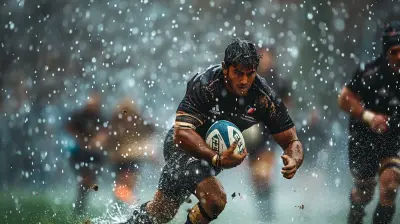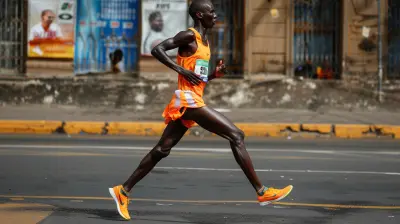The Mental Game of Extreme Sports: How to Overcome Fear
10 July 2025
Extreme sports are some of the most thrilling, adrenaline-packed experiences on the planet. From base jumping and rock climbing to motocross and big wave surfing—these pursuits demand physical strength, skill, and insane guts. But here’s the kicker—what separates the good from the great isn’t just physical ability. It’s the mental game. Especially the part about fear.
Let’s be real. Fear is the ever-present shadow that comes with pushing our limits. You can’t escape it. But you can learn to dance with it.
In this post, we’re diving deep into the mental side of extreme sports and unpacking exactly how athletes overcome fear. This isn’t just for pros, though. Whether you’re a weekend warrior or eyeing your next crazy challenge, understanding how to master your mind can take your game to a whole new level.
Why Fear is a Key Player in Extreme Sports
First off, let’s give credit where it’s due—fear isn’t the villain. It’s actually a survival tool. It's your brain’s way of saying, “Yo! This could be dangerous. Are you sure?” That gut feeling? Totally normal. In fact, it’s necessary.But here’s the thing: in extreme sports, you’re constantly toeing the line between danger and thrill. Fear is part of the ride. The trick is not letting it drive.
So, how do the best athletes deal with it? Let’s unpack the mental strategies they use so you can take a few pages out of their playbook.
1. Understanding the Nature of Fear
Fear isn’t just “scared.” It shows up in all kinds of sneaky ways—doubt, overthinking, hesitation. Before you can conquer it, you’ve got to understand it.Fear mostly comes from two places:
- The Unknown: New terrain, a new trick, a higher jump than usual.
- Past Experience: Maybe you wiped out before, and now your brain’s like, “Let’s not do that again.”
Once you recognize where your fear is coming from, you can start separating real danger from your mind playing tricks on you.
PRO TIP: Name Your Fear
Sounds weird, but give your fear a name. Talk to it. “Hey Carl, I see you’re back. Cool. But I got this.” You take its power away by acknowledging it rather than ignoring it.
2. Building Confidence Through Preparation
Confidence kills fear. But confidence doesn’t come outta nowhere. It’s built through effort, training, and readiness.Think about it: The more you know your gear, your environment, and your body, the less space there is for doubt. Elite athletes don’t just wing it—they train like maniacs. Repetition builds muscle memory, and muscle memory builds trust.
Practice Makes Possible
The more you expose yourself to a situation, the less scary it becomes. Tech your cliff drops. Run the course. Practice the trick a thousand times. That’s how you rewire your brain to believe you’ve got it under control.
3. Visualization: Your Mind’s Secret Weapon
Ever see a snowboarder at the top of a halfpipe with their eyes closed, nodding slowly? That’s visualization in action.See It Before You Do It
Visualization is more than just daydreaming. It’s mentally rehearsing your moves so your brain can “experience” the challenge before your body does.Imagine the drop. Feel the wind. See yourself sticking the landing. The more vividly and consistently you visualize success, the more your brain believes it’s real.
And belief is powerful.
4. Breathing: The Calm Within Chaos
You’re standing at the edge. Heart racing. Palms sweaty. Time slows down. You’re either gonna freeze... or fly.This is where your breath becomes your best friend.
Breath = Control
Slow, deep breathing reduces your heart rate and tells your nervous system that you’re not actually dying. Sounds dramatic, but it’s true. When you're scared, your body goes into fight-or-flight mode. Breathing breaks that cycle.Try this before a big moment: Inhale for 4 seconds, hold for 4, exhale for 6. Do this a few times. You’ll feel your heartbeat slow, and your focus sharpen.
5. Break It Down—One Step at a Time
When you look at the whole challenge at once, it can be overwhelming. Like, “Holy crap, I have to ride down THAT?”Instead, chunk it up. Focus on the next move. Just the next turn, the next jump, the next grip.
Extreme athletes often talk about “flow state”—that zone where everything fades and it’s just you and the moment. Breaking things into micro-goals is a fast track to flow.
Micro-Wins = Big Confidence
Each time you take one small step, you build momentum. And momentum crushes fear.6. Positive Self-Talk: Be Your Own Hype Man
Your inner voice can make or break you. If it’s saying “You’re gonna crash” or “You’re not ready,” then yeah, guess what? You're probably gonna eat it.But what if your voice said, “You’ve trained for this. You’ve done harder things. You got this”?
That’s not cheesy. That’s strategy.
Own Your Inner Dialogue
Athletes who win the mental game talk to themselves like champions. Practice affirmations. Use mantras. “I am calm. I am strong. I commit.”Say it like you mean it. Your brain listens.
7. Learn from Failure Without Letting It Own You
Here’s the uncomfortable truth: You will fail. You will fall. You might even get hurt. That’s the nature of pushing boundaries.But fear of failure shouldn't stop you. If anything, it should teach you.
Fail Forward
Every gnarly wipeout carries a lesson. Maybe your gear wasn’t right. Maybe your timing was off. Maybe you weren’t mentally present.The key is to analyze it, learn from it, and let it go.
Remember: The most fearless athletes are often the ones who have failed the most—and used every failure as a stepping-stone.
8. Surround Yourself With the Right Vibe
Ever notice how stoked you feel around other passionate people? That’s not coincidence. Energy is contagious.If the people you train with lift you up, challenge you, and believe in you, fear doesn’t stand a chance.
Community Builds Courage
Having a solid tribe gives you a safety net—mentally and emotionally. They’ll celebrate your wins, support you through setbacks, and push you when you hesitate.So choose your crew wisely. Their mindset becomes part of yours.
9. Know the Difference Between Fear and Intuition
This part is important: Not all fear is bad. Sometimes, it’s your gut warning you when something genuinely isn’t right—wrong conditions, gear failure, fatigue.Learning to distinguish between fear that holds you back and intuition that protects you is key.
Trust Your Gut, Not Your Gremlins
Ask yourself: Is this fear based on ego or safety? Am I hesitating because I’m scared or because I’m not ready?Listening to your intuition builds self-awareness and keeps you sharp. It’s not about avoiding risk—it’s about making smart calls.
10. Commit Fully—or Don’t Go
Half-sending is a recipe for disaster. Ask any extreme sports athlete if they’ve ever regretted not fully committing to a trick, and you’ll hear all kinds of horror stories.Once you decide to go, you’ve got to go all in.
100% or 0%
There’s magic in full commitment. When your mind is clear and decisive, your body follows. Fear loses its grip because you’re no longer teetering in indecision.So whether it’s a backflip, a big drop, or a first-time cliff dive—make the choice, own it, send it.
Final Thoughts: Courage Isn’t The Absence of Fear
Let’s wrap this up with some real talk. Being fearless? That’s a myth. Every pro you admire still feels fear. They just don’t let it stop them.Courage isn’t about not being scared. It’s about doing the thing even though you’re scared.
Extreme sports don’t demand perfection. But they do demand presence. They ask you to show up as your most focused, committed, and honest self.
So gear up mentally. Build your self-belief like you build your strength. And next time fear taps you on the shoulder—nod, smile, and go anyway.
You’ve got this.
all images in this post were generated using AI tools
Category:
Extreme SportsAuthor:

Uziel Franco
Discussion
rate this article
1 comments
Zeth Reed
This article highlights the crucial role of mental strength in extreme sports. Overcoming fear is essential for athletes to reach their full potential. Embracing challenges and practicing mindfulness can significantly enhance performance and confidence. A must-read for thrill-seekers!
July 24, 2025 at 3:55 AM

Uziel Franco
Thank you! I'm glad you found the article insightful. Mental strength truly is vital for athletes in extreme sports. Embracing challenges can make all the difference!


